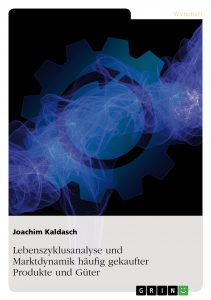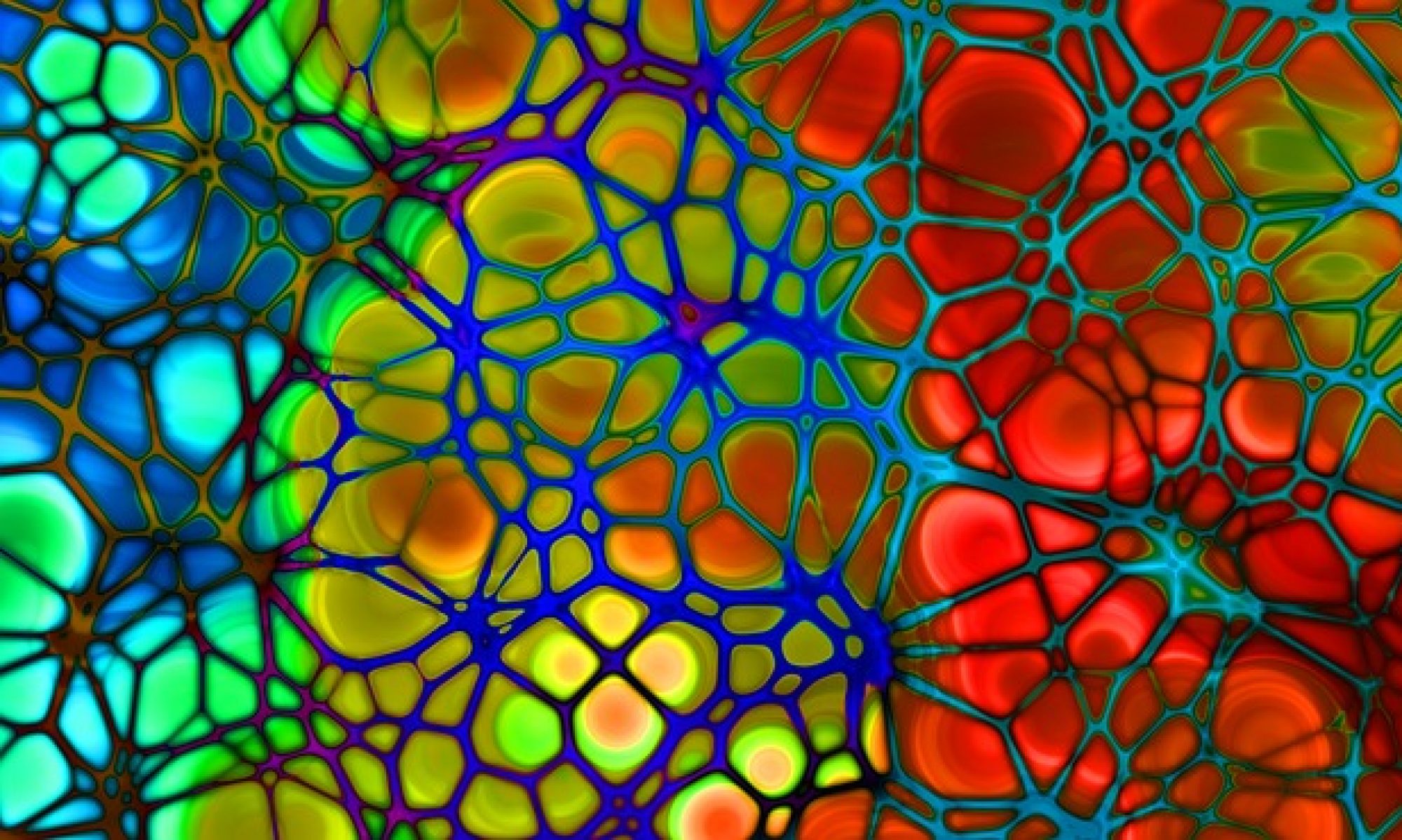Life Cycle Analysis of Products and Goods
Book: Life Cycle Analysis and Market Dynamics of Frequently Purchased Products and Goods

This book uses the business life cycle concept and generalizes it to a microeconomic lifecycle concept of goods and products. Starting point is the modeling of the reproduction process in order to describe the sales, supply and price evolution of frequently purchased products and goods. Also considered are: the distribution of prices, the competitive dynamics of products / suppliers, the development of subsequent generations and product-models, growth rates and size distribution pf products, and the evolutionary adaptation of goods.
The lifecycle concept is one of the concepts most widely used in economic literature. The idea is that nothing lasts forever. The development of economic objects, like organisms, are subject to a life cycle. This book is primarily devoted to the understanding of the life cycles of products and goods.
The textbook from GRIN Verlag (2017) is available from Amazon.
Table of Contents:
content
Foreword 4
1 Introduction 6
2 Sales Evolution of Goods and Products 13
2.1 The Activation Model 14
2.2 The First Generation GLC 20
2.3 The GLC of Subsequent Generations 26
2.4 Heterogeneous Goods and Networks 30
2.5 Summary and Comparison with Empirical Data 37
3 The Supply and Price Evolution of Goods and Products 61
3.1 The Short-Term Price Distribution 61
3.2 The Dynamics of the Mean Price 66
3.3 The Supply Dynamics 70
3.4 The Long-term Price Trend 72
3.5 The Competitive Dynamics of Products 77
3.6 The Evolutionary Adaptation of Goods 81
3.7 Summary and Comparison with Empirical Data 84
4 Concluding remarks 103
5 Annexes 105
5.1 Annex A: Short-term Price Distribution 105
5.2 Annex B: The Effective Price Distribution 109
5.3 Annex C: Price Instabilities 111
5.4 Annex D: Stability Analysis 113
5.5 Annex E: Price Oscillations 115
5.6 Annex F: The Size Distribution of Products (Suppliers) 116
5.7 Annex G: Distribution of Growth Rates of Products 120
5.8 Appendix H: The Number of Products/Suppliers 124
5.9 Annex I: Diffusion in a Producer Market 126
6 Bibliography 128
7 Index 132
Foreword
The lifecycle concept is one of the concepts most widely used in economic literature. The idea is that nothing lasts forever. The development of economic objects, like an organism, is subject to a life cycle. This approach also applies to the goods life cycle, the brand life cycle, the technology life cycle, the company life cycle, etc. (Fischer M, 2001) (Bernecker M, 2017). Above all, this book is dedicated to the understanding of the life cycles of products and goods (abbreviated as PLC and GLZ).
In general, goods are understood to be all means and services that give specific benefits and thus serve the satisfaction of needs. They can be distinguished from one another by the properties of use. In contrast, products are variants of a good from various suppliers (manufacturers), which, from the perspective of the customer, have very similar benefits, but may differ in price. If there is only one supplier (manufacturer, producer …) then the product and the goods life cycle are identical. However, if there are several suppliers of similar products, there is the possibility of mutual substitution. The resulting competitive dynamics can lead to a different but interdependent course of the product and goods life cycle. In the foreground of this book is a quantitative modeling and analysis of the sales and price evolution of frequently purchased goods and products. The aim is to analyze the life cycle dynamics from a microeconomic rather than a business point of view in order to make it more accessible to data analysis.
The basic idea of the lifecycle concept is the ability to divide the time evolution of the unit sales into specific phases. For the life cycle of products / goods, the phases are often differentiated in terms of sales into: introduction phase, growth phase, maturity phase, saturation phase and degeneration phase (Rogers EM, 2003). The business life cycle concept is based primarily on an analysis of the sales and profit evolution of a product. While in the introductory phase, no profits are generated and the promotion of the product is in the center of the business activities, a product enters the growth phase on reaching the break-even point. Revenue growth weakens in the maturity phase, while most of the profit is made. In the saturation phase, the conversion goes into a saturation state and decreases in the degeneration phase. Ideally, the PLC represents the “life cycle” of a product from the market launch to market exit.
Product life cycle analysis has proven to be a useful strategy tool for businesses. Consideration of turnover, sales volumes and profit allow for adequate company decisions, for example on production capacities (operations research) and the use of marketing instruments (Feichtinger G, 1982) (Hollensen S, 2010). The benefit of the concept lies in the fact that strategic decisions depend on the current state in the life cycle of the good / product. The associated tool is the product lifecycle management (Eigner M, Stelzer R, 2012). It is based on a seamless integration of all information generated during the lifecycle of a product / good, using modern IT systems for recording and managing the data (Eigner M, 2012). Data-based product lifecycle management provides a GLZ / PLZ concept of methods for adapting processes and organizational structures of companies.
We are currently witnessing a revolution in information technology associated with an explosion of digital data, known as big data (Fasel D, 2016). Computers, mobile devices and electronic sensors generate huge amounts of data in the order of zettabytes. Suitable algorithms allow the data to be scoured and, through cross-linking with other data, to gain completely new insides across individual customers in an unprecedented level of detail. They allow, for example, a characterization of customers according to purchase probabilities for products and goods. However, the algorithms provide only limited abilities of analyzing the cause-and-effect relationship. If one wants to interpret the output of a data analysis of sales and price evolution of goods over a longer period of time, one needs a deeper understanding of the relationships between short- and long-term market dynamics.
As it turns out in practice, it is therefore not easy to deduce from price and sales data the corresponding phase of the GLZ / PLZ, in order to make suitable business decisions (Frießem MR, 2013) (Walluschnig M, 2013). The problem is that there is a large variety of the courses of GLZ / PLZ data (Schmidt S, 2009) (Muller JE, 2009) (Wintz T, 2010).
This book is based on a microeconomic approach. The idea is to understand the GLZ from the interplay of characteristic microeconomic processes related to supply, demand and price evolution. The considerations focus on frequently purchased goods and products. There market dynamics are primarily determined not by random individual events, but by the dynamics of these processes.For these goods fluctuations in the data can be neglected to a first approximation.
The book introduces a microcosmic version of the lifecycle model. It not only serves to understand the market dynamics of goods and products, but can also be used as a tool to analyze sales and price trends over short and long periods of time.

